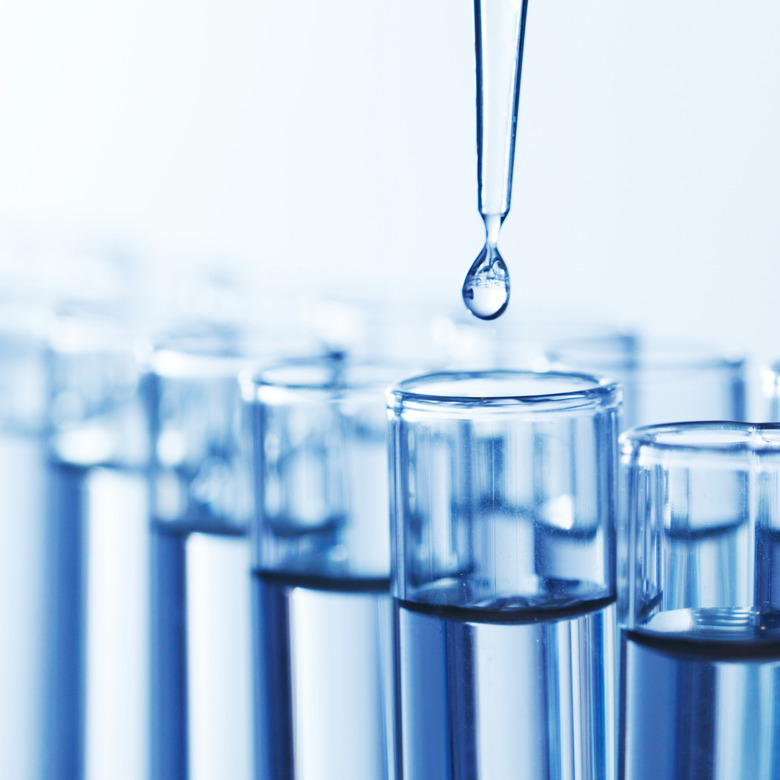How To Dilute Acid
The safe handling of acids and bases is one of the first practices you learn in college-level chemistry. For example, when you dilute an acid to make a lower concentration, you never add water to acid, you instead add acid to water. It may seem at first that it shouldn't matter, but adding water to acid creates a hazardous situation, so adding acid to water is safer.
TL;DR (Too Long; Didn't Read)
Always add acid to water, never the other way around.
Why Dilute Acids?
Why Dilute Acids?
You dilute acids to lower the amount of dissolved substance in the solution. It doesn't make the acid weaker or less reactive. It lowers the amount of acid present in the solution you're working with. For a chemical reaction, you want to match the amounts of reactants to one another, so the reaction consumes each reactant completely. Otherwise, leftover reactants will contaminate the reaction products. You also dilute acids when you work with concentrated storeroom supplies of them. For example, if you bought nitric acid from a chemical supplier, it is typically in a highly concentrated form. To use it, you draw a small amount from the vendor's container, and mix the sample with water for your own experiments.
A Split Second
A Split Second
When you add water to strong acid, in the tiny fraction of a second after the first drop of water touches the acid, a small "pool" of concentrated H+ ions forms. This reaction is strongly exothermic (heat-producing) and the solution at that point is dangerously caustic. With the sudden rise in temperature, the acid fumes, boils and splashes almost instantly, creating a hazardous situation for anyone nearby.
By contrast, adding acid to water creates a small pool of dilute acid at the moment of contact. The reaction is still exothermic but releases little heat. The chance for bubbling and splashing is greatly reduced, and the dilute acid produced is less harmful than in the prior situation.
How to Dilute Acids
How to Dilute Acids
Before you perform the dilution itself, calculate the amount of water and acid needed for the desired concentration. For example, to make 100 mL of .01 molar (M) hydrochloric acid, use 10 mL of .1 molar acid and 90 mL of water. Obtain the correct amounts of deionized (DI) water in one beaker and acid in another. Slowly pour all the acid into the water. Allow a minute or two for the acid to mix before using it, or stir gently with a clean glass rod, then rinse it in DI water.
How to Dilute Bases
How to Dilute Bases
A similar situation exists for diluting strong bases such as potassium hydroxide. The reaction is strongly exothermic and creates the same bubbling and splash hazard as with acid. What's different is when you add water to a base, a strong concentration of hydroxide ions (OH-) forms at the point where the base contacts the water. The safe practice is to add the base to water.
Other Safe Practices
Other Safe Practices
Always wear appropriate personal protective equipment (PPE) such as goggles and disposable gloves when working with strong acids and bases. Closed-toe shoes and pants that cover the ankles are also necessary. Always work with clean glassware. For concentrated acids and bases, safety requirements get more stringent. Work with them only in a fume hood. You may also need other PPE such as an apron, elbow-length neoprene gloves or a face shield when necessary.
Cite This Article
MLA
Papiewski, John. "How To Dilute Acid" sciencing.com, https://www.sciencing.com/how-to-dilute-acid-13710252/. 27 March 2018.
APA
Papiewski, John. (2018, March 27). How To Dilute Acid. sciencing.com. Retrieved from https://www.sciencing.com/how-to-dilute-acid-13710252/
Chicago
Papiewski, John. How To Dilute Acid last modified August 30, 2022. https://www.sciencing.com/how-to-dilute-acid-13710252/
